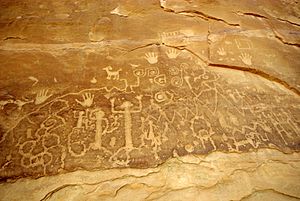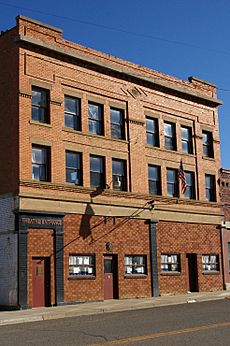Montezuma County, Colorado facts for kids
Quick facts for kids
Montezuma County
|
||
|---|---|---|
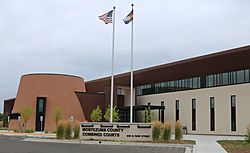
The Montezuma County Combined Courts building in Cortez
|
||
|
||
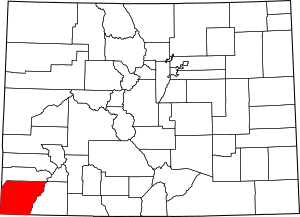
Location within the U.S. state of Colorado
|
||
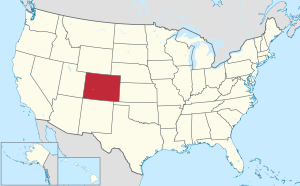 Colorado's location within the U.S. |
||
| Country | ||
| State | ||
| Founded | April 16, 1889 | |
| Named for | Moctezuma II | |
| Seat | Cortez | |
| Largest city | Cortez | |
| Area | ||
| • Total | 2,040 sq mi (5,300 km2) | |
| • Land | 2,030 sq mi (5,300 km2) | |
| • Water | 11 sq mi (30 km2) 0.5%% | |
| Population
(2020)
|
||
| • Total | 25,849 | |
| • Density | 13/sq mi (5/km2) | |
| Time zone | UTC−7 (Mountain) | |
| • Summer (DST) | UTC−6 (MDT) | |
| Congressional district | 3rd | |
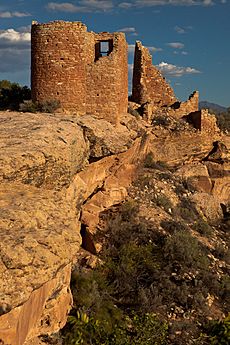
Montezuma County is a county located in the southwest corner of the U.S. state of Colorado. As of the 2020 census, the population was 25,849. The county seat is Cortez.
Montezuma County contains many archaeologically significant Amerindian structures, which notably can be found in Mesa Verde National Park, Canyons of the Ancients National Monument, Yucca House National Monument, and Hovenweep National Monument. Montezuma County is also home to most of the Ute Mountain Indian Reservation, home of the Weeminuche Band of the Ute Nation, known as the Ute Mountain Ute Tribe, with its headquarters at Towaoc.
Contents
History
Montezuma County has been settled since approximately AD 600, and had an estimated population of approximately 100,000, four times its current population, in the 12th century. However, a series of events caused virtually all permanent settlements to be abandoned between 1200 and 1300, and the area was contested between nomadic Ute and Navajo bands until resettlement occurred in the 1870s. Montezuma County was created out of the western portion of La Plata County by the Colorado Legislature in April 1889. It was named in honor of Moctezuma II, who reigned as emperor of the Aztec Empire in Mexico during its decline at the hands of the Spanish invasion. The building ruins in Mesa Verde National Park were thought to be of Aztec origin at the time.
Geography
According to the U.S. Census Bureau, the county has a total area of 2,040 square miles (5,300 km2), of which 2,030 square miles (5,300 km2) is land and 11 square miles (28 km2) (0.5%) is water.
A large county, roughly 1/3 of its area is tribal land, 1/3 is federal land (administered by the National Park Service, the United States Forest Service and the Bureau of Land Management), and 1/3 private or state/county land. It is also varied topographically, ranging in elevation from about 6,000 feet (1,800 m) to more than 13,200 feet (4,000 m), and from high Colorado Plateau desert to alpine tundra. The county has the second largest reservoir in Colorado, McPhee Reservoir, many other large reservoirs, and hundreds of private lakes and ponds. Much of the county is irrigated cropland, and it produces fruit, large numbers of cattle and sheep, and beans. It is served by U.S. Highways 160 and 491 (formerly US 666), and by Cortez Municipal Airport. It has no rail service, although both Mancos and Dolores were established as railroad towns in the 1890s.
Adjacent counties

- Dolores County - north
- San Juan County - northeast
- La Plata County - east
- San Juan County, New Mexico - south - New Mexico portion of Four Corners.
- Apache County, Arizona - southwest - Arizona portion of Four Corners.
- San Juan County, Utah - west - Utah portion of Four Corners.
Montezuma County is the only county in the United States to border three counties with the same name in three different states (San Juan County in Colorado, New Mexico, and Utah). The "border" with San Juan County, Colorado, is, however, only a point of zero length.
Major highways
 U.S. Highway 160
U.S. Highway 160 U.S. Highway 491 (former US 666)
U.S. Highway 491 (former US 666) State Highway 41
State Highway 41 State Highway 145
State Highway 145 State Highway 184
State Highway 184
National protected areas

- Calico National Recreation Trail
- Canyons of the Ancients National Monument (part)
- Highline Loop National Recreation Trail
- Hovenweep National Monument (part)
- Lowry Ruin National Historic Landmark, now part of Canyons of the Ancients National Monument
- Mesa Verde National Park
- Mesa Verde Wilderness
- Old Spanish National Historic Trail
- Petroglyph Point National Recreation Trail
- San Juan National Forest
- Yucca House National Monument
State protected area
- Mancos State Park
Other protected area
Trails and byways
- Great Parks Bicycle Route
- San Juan Skyway
- Trail of the Ancients
- Western Express Bicycle Route
Demographics
| Historical population | |||
|---|---|---|---|
| Census | Pop. | %± | |
| 1890 | 1,529 | — | |
| 1900 | 3,058 | 100.0% | |
| 1910 | 5,029 | 64.5% | |
| 1920 | 6,260 | 24.5% | |
| 1930 | 7,798 | 24.6% | |
| 1940 | 10,463 | 34.2% | |
| 1950 | 9,991 | −4.5% | |
| 1960 | 14,024 | 40.4% | |
| 1970 | 12,952 | −7.6% | |
| 1980 | 16,510 | 27.5% | |
| 1990 | 18,762 | 13.6% | |
| 2000 | 23,830 | 27.0% | |
| 2010 | 25,535 | 7.2% | |
| 2020 | 25,849 | 1.2% | |
| 2023 (est.) | 26,531 | 3.9% | |
| U.S. Decennial Census 1790-1960 1900-1990 1990-2000 2010-2020 |
|||
As of the census of 2000, there were 23,830 people, 9,201 households, and 6,514 families residing in the county. The population density was 12 people per square mile (4.6 people/km2). There were 10,497 housing units at an average density of 5 units per square mile (1.9 units/km2). The racial makeup of the county was 81.72% White, 0.14% Black or African American, 11.23% Native American, 0.20% Asian, 0.06% Pacific Islander, 4.26% from other races, and 2.38% from two or more races. 9.50% of the population were Hispanic or Latino of any race.
There were 9,201 households, out of which 33.30% had children under the age of 18 living with them, 56.40% were married couples living together, 10.60% had a female householder with no husband present, and 29.20% were non-families. 24.60% of all households were made up of individuals, and 9.30% had someone living alone who was 65 years of age or older. The average household size was 2.54 and the average family size was 3.04.
In the county, the population was spread out, with 27.50% under the age of 18, 7.10% from 18 to 24, 26.30% from 25 to 44, 25.30% from 45 to 64, and 13.80% who were 65 years of age or older. The median age was 38 years. For every 100 females there were 96.70 males. For every 100 females age 18 and over, there were 92.20 males.
The median income for a household in the county was $32,083, and the median income for a family was $38,071. Males had a median income of $30,666 versus $21,181 for females. The per capita income for the county was $17,003. About 13.10% of families and 16.40% of the population were below the poverty line, including 23.20% of those under age 18 and 14.40% of those age 65 or over.
Communities
City
Towns
Census-designated places
Other unincorporated places
See also
 In Spanish: Condado de Montezuma para niños
In Spanish: Condado de Montezuma para niños



